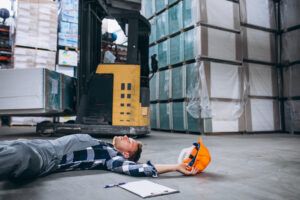According to the Bureau of Labor Statistics, construction sites have one of the highest rates of fatal work injuries in the United States. While safety regulations are in place, accidents can still happen. Thankfully, there are steps we can take to significantly reduce these risks and keep everyone safe on the job.
If you or someone you know has been injured in a construction accident, consulting with construction accident attorneys can help ensure you receive the compensation you deserve. But let’s explore what can be done to prevent these accidents from happening in the first place.
Leading Causes of Construction Site Accidents
Construction sites are a complex dance of human activity and heavy machinery. While progress is the goal, even a small misstep can lead to serious injury. Here’s a breakdown of some of the most common causes of construction site accidents:
Falls
Imagine a towering scaffold or a steep roof—a fall from height can have devastating consequences. But falls aren’t limited to high places. Slips and trips on uneven surfaces or cluttered walkways are just as dangerous. These incidents are often caused by improper use of equipment, like ladders, or the lack of proper fall protection gear, like harnesses and guardrails.
Struck-by Incidents
Being struck by an object on a construction site is a real danger. This could be anything from falling debris like tools or materials to swinging objects like crane loads or misplaced materials being moved by forklifts.
These accidents often stem from inadequate communication between workers, poor housekeeping practices that clutter walkways, or blind spots created by large equipment.
Caught-Between Incidents
Construction machinery is powerful and unforgiving. Workers can become pinched, crushed, or entangled if caught in gears, rollers, or other moving parts. Improper training on safely operating machinery or the lack of proper guards on equipment are major contributors to these incidents.
Electrocution
Electrical hazards are a constant threat on construction sites. Exposed wiring, improper grounding, or damaged cords can all lead to serious electrical shocks, which can be fatal.
Implementing Preventative Measures
Preventing accidents on a construction site isn’t about luck – it’s about proactive planning and a commitment to safety. Here are some key measures that can significantly reduce risks:
Pre-Construction Planning
Safety doesn’t begin when the hammering starts – it starts on the drawing board. A thorough pre-construction phase should involve identifying potential hazards and developing a mitigation plan. This includes creating a site-specific safety plan and conducting comprehensive risk assessments to pinpoint areas of concern.

Worker Training and Education
Knowledge is power, especially on a construction site. Equipping workers with the right knowledge is paramount. Comprehensive safety training programs should cover everything from fall protection and hazard recognition to the safe use of specific equipment. Regular refresher courses ensure that everyone stays up-to-date on best practices.
Personal Protective Equipment (PPE)
Think of PPE as a worker’s suit of armor. Hard hats, safety glasses, respirators, and fall protection gear are all essential tools to prevent serious injuries. Employers are responsible for providing the right PPE for the job, while workers must wear and maintain it properly.
Site Safety Protocols
Clear and consistent safety protocols are the backbone of a safe work environment. These protocols should cover everything from daily housekeeping routines to clear signage and communication protocols. Examples include regular inspections to identify and address hazards and established procedures for reporting unsafe work conditions or near misses.
Enforcing Safety: Roles and Responsibilities
Creating a culture of safety on a construction site is a shared responsibility. Here’s a breakdown of the key players and their roles:
- Employers: The buck stops with the employer. They have a legal responsibility to provide a safe work environment. This includes enforcing safety protocols, conducting regular safety training, and providing proper PPE.
- Workers: Workers play a vital role in their own safety and the safety of their colleagues. They must follow established safety protocols, report any unsafe work conditions or hazards they encounter, and use PPE correctly.
- Regulatory Agencies: Government agencies like OSHA (Occupational Safety and Health Administration) set safety standards for construction sites and conduct inspections to ensure compliance. These inspections help identify and address potential hazards before they cause accidents.
The Benefits of Preventing Construction Site Accidents
Construction accidents are a human tragedy. Injuries and even fatalities can have a devastating impact on workers and their families. The financial cost is significant, too, with medical expenses and lost productivity taking a toll.
However, by prioritizing safety, construction companies can create a win-win situation. A strong safety culture leads to fewer accidents, improved worker morale, and, ultimately, lower costs for everyone involved.












